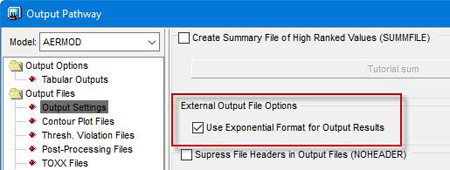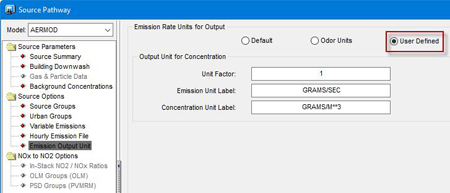Lakes Environmental Newsletter
In this issue:
- News & Events
- Upcoming Courses
- Modeling Tip: When Numerical Values Are Outside AERMOD’s Default Threshold
- Articles
- Upcoming Conferences & Trade Shows
News & Events
Lakes Sister Company Releases Cloud Encryption App - Zebu Lockbox
To resolve these problems, Lakes Environmental Software’s sister company is pleased to announce the release of Zebu Lockbox – a cloud encryption app that allows users to fully protect files stored on Dropbox and Google Drive and fully meet ever-increasing security and data governance obligations when managing business data, clients’ files, and privileged communications. Environmental consultants, industry and regulatory agencies commonly deal with sensitive or proprietary information and can now ensure full protection of this information.
To ensure that our customers have the tools they need to protect their personal, business and client data we are making Lockbox available to all our customers for free. Lockbox ensures that all your files and information in the cloud are safe and only accessible by you.
Simply Download and install Lockbox to provide immediate protection of your sensitive information!
Parallel AERMOD Webinar – Save the Date!
AERMOD and CALPUFF Courses in Toronto – Feb 26 – Mar 1, 2018
Lakes Environmental will hold four days of AERMOD and CALPUFF training in Toronto from February 26 to March 1, 2018.
|
The AERMOD portion of this course will feature a special section and case study regarding the dispersion modeling requirements of Ontario Regulation 419/05: Air Pollution - Local Air Quality. Register now to take advantage of our Early Registration Discount! Available until January 26, 2018 Course: AERMOD (Feb 26-27, 2018) |
AERMOD & CALPUFF Courses in Las Vegas – April 30 – May 4, 2018
Lakes Environmental will be hosting a full week of AERMOD and CALPUFF training in Las Vegas from April 30 to May 4, 2018.
|
The CALPUFF portion of this course will include a special Class I Area Visibility case study and WRF case study for each student’s desired location. Register now to take advantage of our Early Registration Discount ending March 15, 2018. Course: AERMOD (Apr 30-May 1, 2018) |
AERMOD and Risk Assessment Courses in Sydney, Australia – May 14-17, 2018
Lakes Environmental and the Clean Air Society of Australia & New Zealand (CASANZ) will hold 4 days of AERMOD and Air Toxics Human Health Risk Assessment training in Sydney from May 14 to 17, 2018.
If you are interested in registering for these courses, please contact the CASANZ Training Administrator at jacinda@casanz.org.au.
|
Further details including course venue and online registration can be found on the CASANZ website. Early Bird Registration Closes: March 2, 2018 Course: AERMOD (May 14-15, 2018) |
Upcoming Courses
Date |
Course |
Location |
Registration |
Feb 26-27, 2018 |
|||
Apr 17-18, 2018 |
London, UK |
Registration |
|
Apr 30-May 1, 2018 |
|||
May 14-15, 2018 |
Sydney, Australia1 |
||
May 16-17, 2018 |
Sydney, Australia1 |
||
Jul 16-19, 2018 |
Gauteng, South Africa2 |
Registration |
|
Oct 15-18, 2018 |
Dubai, UAE |
Registration |
|
Nov 26-28, 2018 |
Săo Paulo, Brazil |
Registration |
1Sponsored by CASANZ
2Sponsored by NACA
For more information on the above courses, including registration information, location, and course outlines, please visit our web site: https://www.weblakes.com/courses.html.
Modeling Tip
When Numerical Values Are Outside AERMOD’s Default Threshold
A standard model run using the AERMOD air dispersion model produces numerical output with up to 13 significant figures (e.g., xxxxxxxx.xxxxx). Projects which use very low or very high emission rates may run into a problem where the model outputs values which do not fit properly within this limit. For examples, concentration values of 1E9 units or higher will result in a field of asterisks written to the output file as shown below.
ALL HIGH 1ST HIGH VALUE IS************** ON YYMMDDHH: AT ( XXXXXX.00, YYYYYYY.00, ZZZ.00, HHHH.00, 0.00) GC UCART1
Concentrations which are below or very near to the default reporting threshold (1E-5) will result in repeating values of 0.00000 or 0.00001. With so many repeating values, AERMOD View becomes unable to properly generate contours due to the lack of precision.
The AERMOD model features two ways to handle this issue.
|
Submit Your Modeling Tips Today!
We are currently accepting submissions for the Monthly Modeling Tip section that appears in our newsletters. If you have a modeling tip that may benefit our readers, please send it to us at support@webLakes.com. Your name and the name of your organization will appear below the tip providing you with an opportunity for increased exposure.
Articles
Vehicles Are Now America's Biggest CO2 Source But EPA is Tearing Up Regulations
January 1, 2018 - Some of the most common avatars of climate change – hulking power stations and billowing smokestacks – may need a slight update. For the first time in more than 40 years, the largest source of greenhouse gas pollution in the US isn’t electricity production but transport – cars, trucks, planes, trains and shipping.
Emissions data has placed transport as the new king of climate-warming pollution at a time when the Trump administration is reviewing or tearing up regulations that would set tougher emissions standards for car and truck companies. Republicans in Congress are also pushing new fuel economy rules they say will lower costs for American drivers but could also weaken emissions standards.
Opponents of the administration fret this agenda will imperil public health and hinder the effort to address climate change.
Toxic Trade: Old Cars Poisoning Kampala City
December 31, 2017 - The Suzuki vehicle belonging to Godfrey Kaggwa at Kasangati town in Wakiso district is similar to the Biblical Lazarus, who came back to life in one of the many miracles performed by Jesus.
Though it celebrated its 30th birthday recently, it has not retired. And it is not alone. Many other vehicles that should be on the scrapyard are plying their trade in Kampala, despite the dangers they pose. Dr Tom Okurut, the executive director of the National Environment Management Authority (NEMA), reckons that probably there is no better place in the world to dump old cars than in Uganda.
Short-Term Exposure to Low Levels of Air Pollution Linked with Premature Death Among U.S. Seniors
December 28, 2017 - Short-term exposures to fine particulate air pollution and ozone—even at levels well below current national safety standards—were linked to higher risk of premature death among the elderly in the U.S. according to a new study from Harvard T.H. Chan School of Public Health.
The risk was even higher among elderly who were low-income, female, or Black.
The study was published December 26, 2017 in the Journal of the American Medical Association (JAMA).
Scientists Discover Unexpected Side Effect to Cleaning Up Urban Air
December 19, 2017 - An imbalance between the trends in two common air pollutants is unexpectedly triggering the creation of a class of airborne organic compounds not usually found in the atmosphere over urban areas of North America, according to a new study from Caltech.
For decades, efforts to reduce air pollution have led to cleaner air in U.S cities like Los Angeles, with subsequent improvements in public health. Those efforts have targeted both nitric oxides and hydrocarbons. Nitric oxide is a compound of nitrogen and oxygen emitted from engines (especially those powered by diesel fuel) and from coal power plants. Hydrocarbons, meanwhile, are the family of molecules made from chaining together hydrogen and carbon. These molecules are emitted from many sources including gasoline-powered cars, trucks, solvents, cleaners used both at home and in industrial settings, and even trees.
Peru Adopts Euro 4 / IV Vehicle Emissions Standards for Improved Air Quality
December 18, 2017 - On 30 November 2017, Peru adopted the Supreme Decree No. 010- 2017-MINAM presented by the Ministry of Environment, which establishes maximum permissible limits of atmospheric emissions for vehicles. As of 1 April 2018, vehicle emission standards will be Euro 4/IV, Tier 2 and EPA 2007.
This measure will contribute to the reduction of pollutants from motor vehicles, leading to improved air quality, with benefits to health and the environment. It is estimated that emissions of nitrogen oxides will be reduced by up to 35 per cent and particulate matter (PM 2.5) by up to 70 per cent.
For additional environmental news, visit the Environmental News Network (ENN), the most
dependable online environmental news source!

Upcoming Conferences & Trade Shows
Feb 7-9, 2018 |
2018 9th International Conference on Environmental Science and Development (ICESD 2018) |
Paris, France |
Feb 19-20, 2018 |
20th International Conference on Air Pollution and Control |
Paris, France |
Feb 26-Mar 2, 2018 |
2nd Pan-GASS Meeting - Understanding and Modelling Atmospheric Processes |
Lorne, VIC, Australia |
Mar 5-7, 2018 |
Energy, Utility & Environment Conference (EUEC) 2018 |
San Diego, CA, USA |
Mar 14-16, 2018 |
GLOBE Leadership Summit for Sustainable Business and Innovation Expo |
Vancouver, BC, Canada |
Apr 8-10, 2018 |
3rd International Conference on Air, Water, and Soil Pollution and Treatment (AWSPT'18) |
Budapest, Hungary |
May 8-10, 2018 |
Canadian Environmental Conference and Tradeshow (CANECT) 2018 |
Vaughan, ON, Canada |
May 15-16, 2018 |
Texas Commission on Environmental Quality Environmental Trade Fair & Conference |
Austin, TX, USA |
Jun 25-28, 2018 |
111th Air & Waste Management Association's Annual Conference & Exhibition (ACE) |
Hartford, CT, USA |
About this Newsletter
This newsletter contains information gleaned from various sources on the web, with complete links to the sources cited. Organizations cited are in no way affiliated with Lakes Environmental Software.
Lakes Environmental Software is a leading environmental IT company that offers a complete line of air dispersion modeling, risk assessment, emissions inventory, and emergency release software as well as training and custom software services. With satisfied users located around the globe, Lakes Environmental Software will continue to revolutionize the environmental software field.
For more information please visit our web site at: www.webLakes.com. You may also contact us by phone at (519) 746-5995.
All comments and suggestions are welcome. You can e-mail us at: support@webLakes.com.








